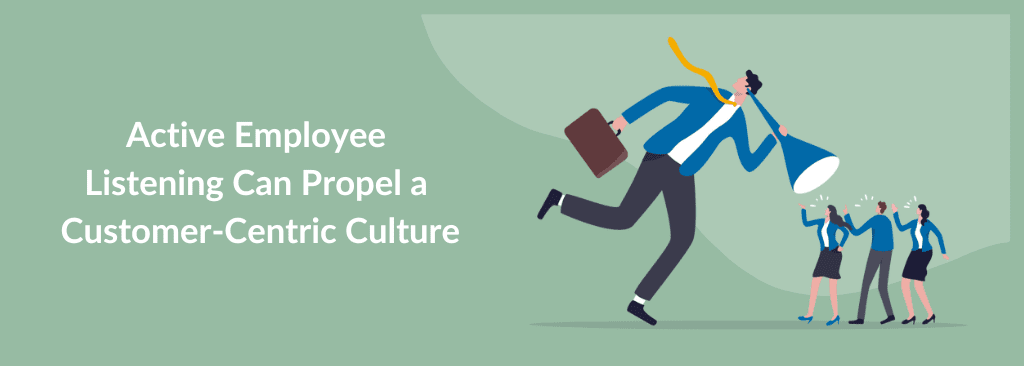Active Employee Listening Can Propel a Customer-Centric Culture
According to Gartner Research, 64% of customer-facing employees say that ‘unnecessary effort” prevents them from delivering a higher-quality experience for customers. This could include anything an employee does on a regular basis that feels to them to be overly complex or repetitive – in a way that negatively impacts their ability to create the best possible experience for customers.
What truly drives customer-centricity is misunderstood in many organizations.
Customer-centricity is not just about getting employees to care more – the majority of employees already do.
Do your employees know what successful customer experience means to your organization and within the context of their role – most customer-facing employees already know this.
Then, why is customer-centricity at a premium?
It is about enabling employees with the right capabilities – empowerment, active listening, and organizational support.
Let us look at a few examples.
Ritz Carlton allows employees $2000 of discretionary spending to take initiatives to solve customers’ problems.
Customers would obviously perceive this brand differently compared to other brands.
Look at the example of Zappos.
Zappos is a customer experience company that happens to be in the business of selling shoes. They allow year-long returns and a 100% refund policy. They have three times higher returns than other providers, but Zappos considers this a small sacrifice to provide confidence to their customers.
Zappos asks its employees to live by the following ten values:
- Deliver WOW through service
- Embrace and drive change
- Create fun and a little weirdness
- Be adventurous, creative, and open-minded
- Pursue growth and learning
- Build open and honest relationships with communication
- Build a positive team and family spirit
- Do more with less
- Be passionate and determined
- Be humble
These operating values allow you to go to any extent to err on the customers’ side. This is how your customers will perceive you as well.
How do you go about creating a customer-centric culture?
Empower Your Customer Service Representatives – The Faces of Your Industry
Customer service reps are your customers’ first point of contact and can make or break your brand.
With their interactions, they can increase the lifetime value of a customer by giving them an unforgettable experience.
For this, the customer service reps must be knowledgeable about the products and services sold to the customers. Also, they should be equipped with easy-to-search knowledge bases and be able to translate that information to the customer in terms that are easy to understand.
Besides, they need access to all the customer transactions and customer interactions on one interface. For this, you will have to integrate all the channels – website, email, voice, chat, SMS, messaging, chatbots, mobile apps, and social.
This also means you must have an omnichannel platform integrated with CRM, helpdesk, and other IT infrastructure.
All of this would create your brand’s credibility in your customer’s minds.
Actively Listen to Your Customer-Facing Resources
Your customer-facing employees are the ones with an ear to the ground. They know exactly why customers reach out to you and what problems they face in using your product or service.
It could be adoption issues, usability issues, or plain communication issues. They need to be documented and added to the knowledge base and FAQs.
Besides, every agent would come across 4 to 5 new use cases every week. They need to be discussed, documented, and shared with all the customer-facing employees.
So, the next time a request like that comes up, you know what to do.
While every organization has these intentions, they don’t do this. This requires discipline and active means to collect feedback from the customer-facing employees.
You cannot stop by just collecting customer feedback; you must close the feedback loop. Only then would employees feel they are a part of the solution and continue contributing.
Implementing every idea suggested by an employee is not necessary. However, it is important to let the employees know the progress of their feedback – this shows your commitment to setting up employees for success.
Organizational Support
A study by MIT Sloan among 562 large U. S. companies to assess how well companies live up to their stated values found zero correlation between what companies say they value and what they do.
Most value statements have great intentions, but they don’t provide directions for employees can contribute to it as a part of their daily work.
This is why Ritz allocates a discretionary spend of $2000 to err on the side of the customers. This is why Zappos doesn’t bother about the average call handling time – we have heard of the legendary Zappos customer calls that lasted many hours but provided excellent customer engagement.
These are part of the folklore. Not every organization can do these, but every organization can provide some guidelines to improve the value for its customers.
To err is common. But always err on the side of the customers should be the motto. If the organization supports this motto, this can cause enormous upside to your customer-centric initiatives, eventually resulting in increased lifetime value and revenues.
Employee experience, too often, has been ignored by organizations. Take the average customer service organization – the reps will have to juggle between multiple screens to find the answer, and they are not provided with the right tools to seek out the answers. This ultimately frustrates the customers.
Put your employee experience first and equip them with the right tools and technology to deliver – your customer experience will become exemplary.
